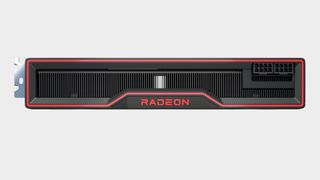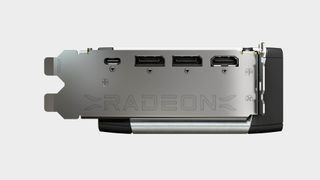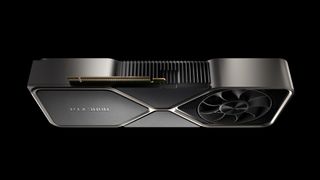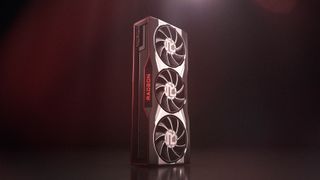Our Verdict
The AMD RX 6900 XT is an impressive feat of sheer performance uplift generation on generation. Yet its high cost and minimal performance benefit over cheaper graphics cards make it difficult to recommend.
For
- Occasionally matches RTX 3090
- Rage Mode easy overclocking
- Power efficient
Against
- Can lag behind an RTX 3080 at times
- High cost with little reward
- Mediocre ray tracing performance
- RX 6800 XT is a better buy
PC Gamer's got your back
After years of waiting, Big Navi is finally here: the AMD Radeon RX 6900 XT. A high-end enthusiast graphics card that existed solely in the hopes and dreams of enthusiasts for over a year—and in the Radeon Technology Group labs for surely much longer—the RX 6900 XT is the ultimate expression of the RDNA 2 architecture.
A known quantity since October, the RX 6900 XT will be a familiar sight for anyone that read our RX 6800 XT review. It features the same triple-fan cooler design, memory configuration, and even TGP and clock speeds as the RX 6800 XT. Hence why plenty of what I spoke about back in November regarding the impressive updates to the RDNA 2 architecture is still valid in regards to the more expensive $999 card.
But the RX 6900 XT takes aim at Nvidia's GeForce RTX 3090, a Titan in all but name, and you'd be right in thinking something must've changed to get anywhere close to realising that lofty goal. There has been one key change to the hardware: Where the RX 6800 XT includes 72 compute units (CUs) for a total of 4,608 stream processors, the RX 6900 XT comes with 80 CUs and 5,120 stream processors.
And I have to say the prospect of a card that comes close to Nvidia's $1,499 graphics card for two-thirds of the price had me excited for a long while. All the amped-up marketing from AMD's 'Where Gaming Begins' worked its magic on me, and any fears I perhaps should've had for a $1,000 graphics card lodged unceremoniously between the RTX 3080 and RTX 3090 melted away like soft-serve on a hot day.
Specifications

What are the AMD RX 6900 XT specs?
The AMD Radeon RX 6900 XT specs sheet is as fully-loaded as it gets. But let's start with the core ingredient: RDNA 2.
As I mentioned previously, if you want a more detailed rundown of AMD's brand new RDNA 2 architecture, you need only look to our RX 6800 XT review's architecture section. There are a lot of improvements over the first generation RDNA gaming architecture to talk about, which likely demands its own deep-dive, but for now, let's focus on the specifics of the RX 6900 XT's implementation.
The same Navi 21 GPU resides within the Radeon RX 6900 XT as the two RX 6800-series graphics cards we've already reviewed, meaning you're getting an identical, and very effective, dual compute unit configuration that's tailor-made for gaming—albeit on a slightly larger scale with the 80 CU RX 6900 XT. That makes for a total of 5,120 stream processors—an 11 percent increase over the RX 6800 XT.
That comes with a price increase, too. The RX 6900 XT is priced at $999, whereas the RX 6800 XT is available (if you can find one in stock) for $649. Both the RX 6800 XT and its little sibling, the $579 RX 6800, are largely unavailable right now, however. We suspect the launch of the RX 6900 XT to go much the same way, if not be more sparsely available as most high-performance GPUs tend to be manufactured at lower quantities.
If you can get your hands on one, you'll be gifted an incredibly well thought-out architecture, with enhancements to clocks and power delivery ensuring the core GPU is running like a well-oiled machine. Even with a high core count and TGP in line with the RX 6800 XT, the RX 6900 XT easily breaches 2.2GHz clocks under load.
GPU: Navi 21
Lithography: TSMC 7nm
Die size: 519 mm2
Transistors: 26.8bn
Stream processors: 5,120
CUs: 80
Ray Accelerators: 80
GPU Game clock: 2,015MHz
GPU Boost clock: 2,250MHz
Memory bus: 256-bit
Memory capacity: 16GB GDDR6
Memory speed: 16Gbps
Memory bandwidth: 512GB/s
TGP: 300W
Recommended power supply: 750W
Size: 2.5-slot
Price (reference): $999
To enable such a chip to operate within the same 300W TGP as the RX 6800 XT, AMD is employing a handful of other optimisations for every Navi 21 GPU destined for the RX 6900 XT. A binning process ensures the Navi 21 GPU within the RX 6900 XT is one of the best samples out of TSMC's 7nm fabs, and each one has been carefully selected for its ability to meet performance requirements while retaining power efficiency.
There's also a minimum VRM power delivery requirement for all RX 6900 XT graphics cards, with the reference AMD model offering 16-phase VRM power delivery. That, AMD says, is the key to maintaining similar wattage to the lower-spec model while maintaining greater performance. That and the binning, of course.
And yes, that is confirmation that there will be third-party models of the RX 6900 XT. These will arrive shortly after launch. For now, however, the RX 6900 XT will only be available in reference garb, the exact same heatsink and cooler design found on the RX 6800 XT. That's one way that the RX 6900 XT has the RTX 3090 immediately beat, too, it's nowhere near as huge. Yet it is still plenty capable of managing the heat produced by that 519 mm2 GPU, running slightly hotter than the RX 6800 XT under load at 74°C, to the second-tier card's 68°C.
Perhaps the most noteworthy function added with RDNA 2 is ray tracing capability, however, made possible by the inclusion of AMD's Ray Accelerators.
These Ray Accelerators are dedicated ray-tracing hardware acceleration blocks fused next to the traditional rendering pipeline. There's one Ray Accelerator for every CU, and so the RX 6900 XT comes with the most ray tracing silicon of the lot at 80. These blocks are specifically designed to accelerate the BVH (bounding volume hierarchy) traversal step, which would usually be a far too compute-heavy step for a GPU without acceleration, as we've seen with 16-series and 10-series ray tracing on older generation Nvidia GPUs.
The remaining steps are carried out on the traditional shader units within the GPU. That's unlike Nvidia's dual RT Core and Tensor Core approach with Ampere, which divvies up denoising to the AI-inference accelerating Tensor Cores. As such, much to the same result as with the previous two RX 6000-series launches, AMD's approach is a little off the pace of Nvidia's RTX 30-series—even the $399 RTX 3060 Ti isn't all that far behind the RX 6900 XT in 3DMark's brand new DirectX Raytracing Feature Test.
But the RX 6900 XT has a significant leg up over the competition in other ways to make up for it. A seriously capacious 16GB of GDDR6 memory helps the RX 6900 XT at least despatch fears of some future VRAM hog eating up all your buffer. That's fed by the same 256-bit memory bus as the other cards, yet as we know that's not quite the end of the story with RDNA 2.
AMD's secret weapon for its high-performance GPUs is its Infinity Cache, a feature it plucked in spirit from its AMD EPYC server chip cache subsystem, and subsequently chopped and changed over the course of a few years before finally unleashing it within the Navi 21 GPU.
We're once again looking at 128MB of Infinity Cache with the RX 6900 XT, the same found with all RX 6000-series cards so far, and that which AMD touts as enough to successfully prevent a slower call to external memory some 60-80 percent of the time. That's all without dramatically increasing die size, cost, or power requirements, it says. Infinity Cache is more effective at lower resolution, too, although seeing as 1080p is less memory intensive than 4K that doesn't always work out as the simple equation it perhaps sounds like.
You'd likely not pick up the RX 6900 XT for merely 1080p gaming alone—not unless you're willing to put your bank account on the line to chase 360Hz refresh rates. For most, the RX 6900 XT is a card for high refresh 1440p and most likely 4K, and in that regard, it delivers where it counts.
Benchmarks & performance

How does the AMD RX 6900 XT perform?
The RX 6900 XT cements its place as a highly-capable 4K graphics card, and often one able to top the performance of the RX 6800 XT by a couple of percent up to high single digits—rarely more. That means you can expect 4K performance that tops 60fps in most modern games.
It's one thing to deliver framerates at 4K, it's another to do it with consistency across multiple games and benchmarks, however. The RX 6900 XT performance is somewhat erratic, to say the least, and that's the case throughout own benchmark results and the results AMD includes in its own reviewer's guide for reference.
The RX 6900 XT rarely meets the RTX 3090 in games, except those where the RX 6800 XT also manages to top the RTX 3080, which is not all that often. Perhaps that's a sign that further sway with developers—off the back of the RDNA 2-powered Xbox and Sony consoles—could work wonders for RDNA 2 performance in future titles. Yet that's not the case today, where Nvidia still dominates the PC market, and we're seeing performance sway in favour of Nvidia's high-end card for the most part.
The RTX 3090 manages to maintain a four percent lead over the RX 6900 XT, which just tops the RTX 3080 by a little under three percent in our benchmarking suite across 1080p, 1440p, and 4K.
4K gaming performance








1440p gaming performance








1080p gaming performance









At 4K, that lead worsens over the RTX 3080, where the RX 6900 XT falls within a single percent of the cheaper card, and the RTX 3090's lead grows to just under 10 percent.
AMD is confident that the 16GB of VRAM across its high-end cards today will come into play more and more with the coming wave of videogames. That's a little nebulous to base a review on right now, even if it's likely to be realised in some form of another eventually. Instead you can guarantee some performance uplift from Rage Mode and Smart Access Memory—two features that generate a slight boost to performance.
It's worth mentioning that overclocking is hardly exclusive—although Rage Mode won't void your warranty, which is a soothing thought to any nervous tweakers. Re-Size BAR support is also set to arrive beyond the AMD Ryzen/Radeon ecosystem in time, but we're yet to know when or what it will offer when it does.
As it stands today, both are a simple switch and impactful enough to make them worth enabling.
Ray tracing performance


Yet if you add ray tracing to the mix, which I'm wont to do with a $999 graphics card in 2020, the RX 6900 XT only just outperforms far lesser cards from the RTX 30-series stack. It only tops the RTX 3060 Ti in 3DMark's purely ray-traced DirectX Raytracing Feature Test by a hair, which means Ray Accelerator to RT Core, AMD's lagging behind.
The more true-to-life Port Royal benchmark offers a more positive image for the RX 6900 XT, bolstered by its rasterised rendering performance, but it's still far off the pace of either the RTX 3080 or RTX 3090.
Power and thermals



The RX 6900 XT is unsurprisingly the hottest enthusiast graphics card, but that's hardly saying much by the impressive performance that all reference designs exhibit with this GPU generation. At 74°C on average, there's hardly much to worry about in terms of thermal performance, and the RX 6900 XT still manages to remain relatively quiet under load. No doubt the triple fan design is working wonders here.
It's not quite as cool as the RTX 3090, but considering the size difference between the two cards that comes as no surprise. You'll still need space enough for a 2.5-slot design with the RX 6900 XT nonetheless.
Performance per watt is once again impressive, with the RX 6900 XT managing to stay generally beneath the RTX 3080 for the most part during operation. RDNA 2 and the 7nm process node undoubtedly work wonders here.
Overclocking and undervolting








CPU: Intel Core i7 10700K
Motherboard: MSI MPG Z490 Gaming Carbon WiFi
RAM: Corsair Vengeance RGB Pro @ 3,200MHz
CPU cooler: Corsair H100i RGB Pro XT
PSU: NZXT 850W
Chassis: DimasTech Mini V2
Rage Mode actually provides a tangible benefit on the RX 6900 XT, that which we didn't see much of with our RX 6800 XT review sample. With AMD already picking out the finest chips for the RX 6900 XT, you'd expect the best overclocking from it across the board, too—silicon lottery be damned.
We saw at least some performance uplift from a 156MHz clock speed increase, the same overclock I've found to be stable across the RX 6000-series. That necessitates a 15 percent power limit increase, too. There's certainly further tweaking to be done here, and likely a fine-tuned OC profile would offer at least marginally tangible benefits. The reference cooler is capable enough, at the very least.
Yet it's undervolting the GPU, even marginally, that offers the most benefit to AMD's top card. If you're power-conscious or would just like a more efficient GPU, we managed to drop voltage a small amount—in turn dropping overall power draw—while retaining much of the same performance as at stock. There's likely further performance to gain here, too, as the AMD Radeon Software is rather timid with its auto-undervolting.
Analysis

What does the AMD RX 6900 XT mean today?
If the RX 6900 XT is one thing: it's a better proposition for gaming alone than an RTX 3090. And why shouldn't it be? It's a 'gaming first' graphics card that has few allusions of being something purpose-built for creative professionals. But would I buy it over an RTX 3080 for $300 more? Absolutely not. It's still a victim of diminishing returns in the high-end graphics card market, whichever way you look at it.
It's effectively the same problem Nvidia faces in launching a graphics card between the RTX 3090 and RTX 3080. The fact of it is, there's not a huge difference between the two Ampere graphics cards in way of gaming performance, and any such Ti or Super card between the two would have to fall far closer to the RTX 3080's $699 price tag than the RTX 3090's $1,499 price tag to make any sense whatsoever.
What we're seeing today is something much to the same effect. The RX 6900 XT is wedged between the RTX 3080 and RTX 3090 in raw performance terms, yet sadly too often a found trading blows with the RTX 3080 to knock the RTX 3090 off its rather wobbly perch. It's also considerably more expensive than the RTX 3080, and while it does manage to make the RTX 3090 appear even more ludicrous for gaming alone at its price, that wasn't exactly difficult.

Still can't decide between red or green? Check out our RTX 3080 review to get the complete picture as it stands today.
The fact of the matter is: The RTX 3080 already makes the RTX 3090 look bad for gaming, that's why Nvidia went out of its way to bill that card as something more—effectively a Quadro on the cheap. That's helped along by the sizeable memory buffer on the RTX 3090: 24GB of GDDR6X.
The RX 6900 XT doesn't manage to win the battle in gaming, nor does it deliver stunning performance in excess of the RX 6800 XT. That's again partially down to memory capacity—the RX 6000-series shares 16GB throughout—leaving just eight CUs to separate the two. The greater CU count offers a boon to performance, sure, but it's hardly a reason to go for the $999 RX 6900 XT over the $649 RX 6800 XT.
And so the RX 6900 XT often ends up trading blows with the cheaper RTX 3080, a battle it doesn't stand a chance of winning with ray tracing performance factored in; it doesn't look to topple the RTX 3090 for pro creators either, as it is not intended to be a replacement for AMD's professional cards (granted, it does offer improvements offer past GPU generations); and it struggles to offer much reason to go for it over the RX 6800 XT, a significantly better deal for much the same hardware.
Frankly, the RX 6900 XT hardly stood a chance. Which I now fear should've been obvious from the very beginning.
Yet I will say this in its favour: The RX 6900 XT delivering anything close to RTX 3090 performance is something of an engineering marvel from a company that for the longest time has washed its hands of high-performance graphics cards in favour of the volume mid-range market. The AMD RTG (Radeon Technology Group) has set itself up with a solid foundation with the so-called 'Big Navi', if only as a point to build upon with the coming generations.
I likely sound a broken record at this point, but it's an exciting time to be a PC gamer, no matter which company, or component, you look to.
But perhaps this is again more praise for the RDNA 2 architecture more so than the RX 6900 XT itself—that which comes with a perhaps misplaced configuration and price point versus the competition.
Verdict

Closing thoughts
The final graphics card launch of 2020, the AMD RX 6900 XT is also the most disappointing. I'll say that with caveat, at least: in that it's perhaps launched with the stiffest competition we've seen in years. There's finally competition in the high-end graphics card market, and the impact and net gain that's sure to come from that if AMD can keep up a competitive edge cannot be understated.
Yet I can't escape that feeling that the RX 6900 XT was oversold as an RTX 3090 killer. While the RX 6900 XT offers materially exceptional frame rates, even at 4K, it's far from enough to justify the frankly absurd cost—only unless observed in total isolation from the AMD and Nvidia's graphics card line-ups. The RX 6800 XT and RTX 3080 are just simply far better value propositions, while having just as much claim to the ultra-enthusiast title as either of the first-string cards, and the often negligible performance delta between Nvidia's second-tier card and AMD's top chip does little to help its cause.
At 4K, the RX 6900 XT struggles to get anywhere close to the RTX 3090, and often falls even behind the RTX 3080 in titles where AMD's graphics cards are less suited. Whether that's set to change with future titles is hardly a consideration we can make today, but even so it only furthers the erratic performance we're already seeing game to game.
It's far more difficult to justify the cost of the RX 6900 XT, sharing as many qualities with far cheaper cards as it does and with the slight performance gain it's able to deliver from its few upgrades"
Even within AMD's line-up, there's again no pressing argument to upgrade. With a $350 price premium over the RX 6800 XT, the RX 6900 XT offers little return on your sizeable investment—the RX 6900 XT is 53 percent more expensive than the RX 6800 XT yet offers just 5.25 percent more performance in the games tested here.
That's why it's strange that AMD is making a point out of the RX 6900 XT being a card built for 'gaming first'. Even Nvidia didn't make that mistake, billing the RTX 3090 as a pro creator card with a substantial increase in memory capacity over the second-run gaming card below to help justify the cost.
It's far more difficult to justify the cost of the RX 6900 XT, sharing as many qualities with far cheaper cards as it does and with the slight performance gain it's able to deliver from its few upgrades. It's simply a card I cannot recommend, even those to which money is no object: Buy an RTX 3090 if you've an appetite for graphics cards as expensive as most peoples' PCs.
While I'm a big fan of RDNA 2 and the leaps AMD RTG has made to get it to compete at this level in a short period of time, the RX 6900 XT is simply not its finest form.
The AMD RX 6900 XT is an impressive feat of sheer performance uplift generation on generation. Yet its high cost and minimal performance benefit over cheaper graphics cards make it difficult to recommend.

Jacob earned his first byline writing for his own tech blog. From there, he graduated to professionally breaking things as hardware writer at PCGamesN, and would go on to run the team as hardware editor. He joined PC Gamer's top staff as senior hardware editor before becoming managing editor of the hardware team, and you'll now find him reporting on the latest developments in the technology and gaming industries and testing the newest PC components.

Rogue Prince of Persia overhauls art style and doubles game size in its biggest update yet

BioWare's art director reveals eight pieces of decade-old concept art for the earliest version of Dragon Age: The Veilguard

Overwatch: Classic has me reckoning with the fact that OG Overwatch kind of sucks, but also that Blizzard could learn a few lessons from it
